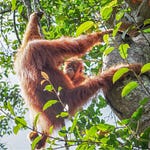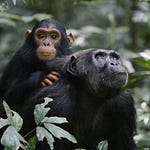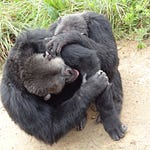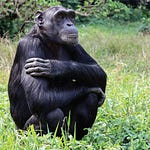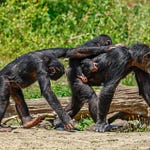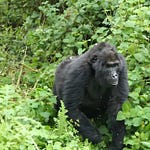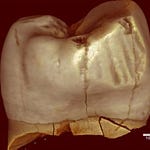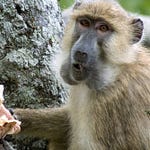Aging and the Chimpanzee Technological Mind
In a quiet clearing deep in the Bossou forest of Guinea, West Africa, wild chimpanzees (Pan troglodytes verus) have long been observed cracking open hard-shelled oil palm nuts using stones. This behavior—at once delicate, deliberate, and learned over years—is one of the most complex forms of nonhuman tool use known in the wild. But for some of these chimpanzees, what begins as an impressive technical tradition fades in old age.
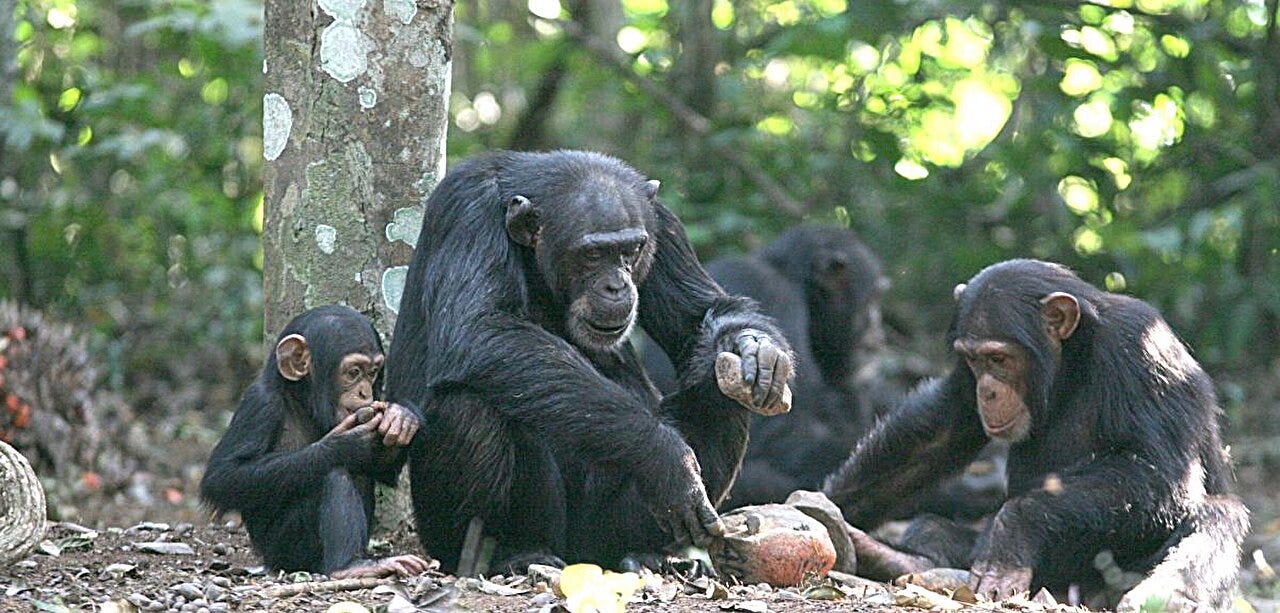
A recent study published in eLife1 by Elliot Howard-Spink and colleagues has drawn back the curtain on this decline. Using a trove of video footage gathered across 17 years, the research team traced how five aging chimpanzees, each between 39 and 61 years old during the observation window, gradually withdrew from nut-cracking behavior. Their analysis captures not only the wear of aging bodies, but also the erosion of cognitive engagement with one of the species’ most culturally embedded behaviors.
"Nut cracking requires strength, dexterity, attention, and decision-making. Its decline in older chimpanzees gives us rare insight into the physiological and cognitive toll of aging in the wild," the researchers note.
Bossou’s Outdoor Laboratory
The study hinges on a unique research infrastructure: an “outdoor laboratory” that was set up in 1988. At this site, chimpanzees voluntarily came to crack open provided nuts using a central matrix of over 50 stone tools. The controlled environment allowed researchers to isolate variables and gather longitudinal data, a rarity in primate fieldwork.
The five chimpanzees under study—Fana, Jire, Velu, Yo, and Tua—were all present at the site when long-term research began in the 1970s. Their familiarity with the tools and the nut-cracking task made them ideal candidates for observing how age alters performance.
Withdrawal in the Twilight Years
The most immediate sign of aging came not in performance but in attendance. Over time, the elderly apes showed up at the outdoor laboratory less often than their younger counterparts. This wasn’t a subtle shift. By 2016, the attendance rate of elderly individuals had fallen to nearly half of what it had been in 1999.
"The drop-off in site visits appears tightly linked to old age, since no similar trend was observed among younger chimpanzees," the researchers write.
And when elderly individuals did show up, some spent noticeably less time engaging with nuts and tools. Two females, Fana and Velu, showed dramatic declines. In later years, they often opted for easier foods like palm fruit or simply rested while others worked.
Tool Use Gets Slower—and Sloppier
For those still participating, the process of nut cracking changed in measurable ways. The time it took to select a stone tool increased for several individuals. Yo, the oldest of the group, was especially affected. Her tool selection became slower and more tentative with each field season.
Once the cracking began, the differences were even more stark. Some elderly chimpanzees needed more time, more actions, and more strikes to complete a task that once took only a few careful hits. Yo’s effort nearly doubled in duration, and the number of strikes she delivered per nut tripled over time. Her motions suggested not just physical decline but possibly changes in visual acuity, grip strength, or cognitive planning.
"Yo and Velu's shift from precise strikes to repeated pounding may reflect a broader decline in fine motor control or compensatory strategies for reduced jaw strength," the team suggested.
Interestingly, the lone male in the group, Tua, maintained his efficiency up until his disappearance in 2013, hinting at significant individual variability in the cognitive and physical toll of aging.
Cultural Senescence and Its Implications
This study is not just about tool use. It is about the fading of a cultural behavior. At Bossou, nut cracking is learned socially, passed down like a family recipe. Chimpanzees begin cracking nuts between the ages of 3.5 and 7, and continue throughout adulthood. The decline in this behavior in older individuals raises important questions about the stability of cultural traditions in long-lived animals.
In humans, the maintenance of skill in late life often depends on early-life proficiency and continued practice. This research suggests something similar might apply to chimpanzees. Those who were more socially central or had more surviving relatives—such as Jire and Fana—appeared to maintain their skills longer.
"Tool use may act as both a mirror of aging and a gauge of broader social and physiological well-being in wild primates," the study argues.
What Chimpanzee Aging Might Tell Us About Ourselves
Aging in wild primates offers an important parallel to human senescence. Unlike laboratory studies, this work captures the slow, natural progression of aging in the wild, shaped by physical terrain, shifting social dynamics, and energy constraints.
The authors propose that these chimpanzees can serve as models for understanding how aging may have affected the technical abilities of early hominins. Stone tools were central to human evolution, but until now, almost nothing was known about how those abilities aged.
"Chimpanzee tool use might be the closest window we have into the twilight of early hominin technology," the team notes.
Closing Thoughts
The slow decline of nut cracking in the Bossou chimpanzees is not just a story of aging. It is a story of memory, skill, and the invisible weight of time. As these individuals aged, they brought into focus a quiet but powerful truth: cultural behaviors, once learned and performed with grace, do not persist forever. In the twilight of life, even the most ingrained traditions can fade—not with a bang, but with the patient wear of age.
Related Research
For readers eager to explore further, here are additional studies relevant to this research:
Berdugo, T. S., et al. (2025). Stability and variation in nut-cracking efficiency among Bossou chimpanzees. Primates, 66(2), 134–150. DOI: 10.1007/s10329-025-01083-z
Almeida-Warren, K., et al. (2022). Spatial memory and planning in wild chimpanzee foraging routes. Nature Ecology & Evolution, 6, 880–888. DOI: 10.1038/s41559-022-01717-5
Lacreuse, A., et al. (2020). Executive function declines in aging primates. Neurobiology of Aging, 92, 52–61. DOI: 10.1016/j.neurobiolaging.2020.03.002
Lowenstine, L. J., et al. (2016). The physical and dental senescence of captive apes: Clinical patterns. Journal of Medical Primatology, 45(5), 207–220. DOI: 10.1111/jmp.12223
Fujisawa, M., et al. (2010). Visual aging in Japanese macaques. Aging Cell, 9(2), 116–125. DOI: 10.1111/j.1474-9726.2009.00541.x
Howard-Spink, E., Matsuzawa, T., Carvalho, S., Hobaiter, C., Almeida-Warren, K., Gruber, T., & Biro, D. (2025). Old age variably impacts chimpanzee engagement and efficiency in stone tool use. eLife, 14(RP105411), RP105411. https://doi.org/10.7554/eLife.105411


